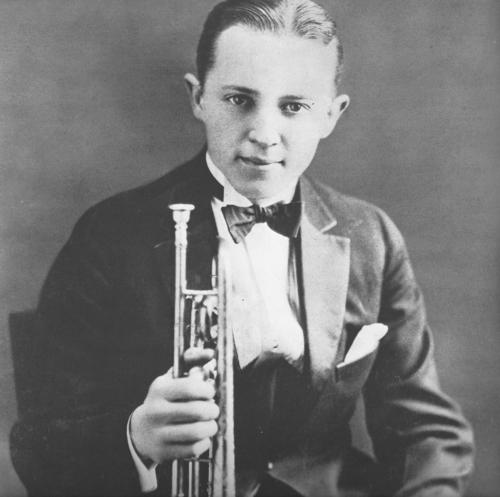
Bix Beiderbecke. Photo courtesy last.fm
The historic Crest Theatre in downtown Sacramento, California serves as the venue for this edition of Riverwalk Jazz featuring The Jim Cullum Jazz Band with the vocal artistry of Australian songstress Nina Ferro. Captured live in 1999 at the Sacramento Jazz Jubilee, this radio show concert was sponsored by the town’s thriving Traditional Jazz Society. Bandleader Jim Cullum and Nina Ferro chose a program with an emphasis on Louis Armstrong, Bix Beiderbecke and songs by Rodgers and Hart, Harry Barris and other tunesmiths from the interwar years’ Golden Age of American Popular Song.
Radio Show Playlist
The Jim Cullum Jazz Band gets our radio concert off to a hot start with two pieces deeply associated with Louis Armstrong:
.jpg)
Louis Armstrong and his Hot Five. Photo in Public Domain.
Composed by King Oliver, “Sugar Foot Strut” was recorded by Louis Armstrong and his Hot Five in 1928. Armstrong’s Hot Five and Hot Seven recordings made in 1920s’ Chicago were the absolute cutting edge of jazz and proved to be highly influential over decades.
“Lazy ‘Sippi Steamer” was first recorded by Louis Armstrong in 1940 and Armstrong is listed among the composers along with his bandleader Luis Russell. The lyric of the song belongs to a genre popular since minstrel times, depicting a “nostalgic” journey down the great river toward a homeland that’s a “welcome sight.” Some eighteen years later, the (by then) media superstar Louis Armstrong was able to publicly express quite a different sentiment—taking to task President Dwight D. Eisenhower and the US Department of State for what Armstrong perceived as a lack of support for the Civil Rights struggle then gaining momentum.
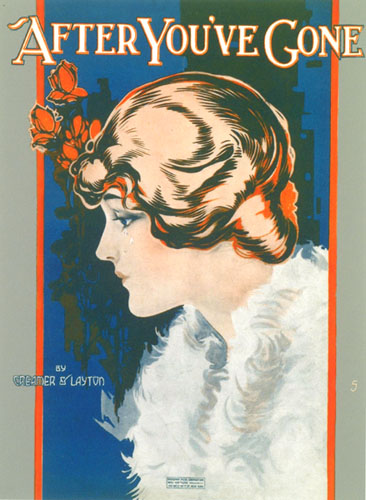
"After You've Gone" sheet music. Image courtesy Wikimedia.
Nina Ferro is welcomed on stage with a romantic number composed by Burton Lane and Ralph Reed —“How About You?” —from the 1941 Judy Garland/Mickey Rooney film Babes on Broadway. Jazz singer Rosemary Clooney recorded a notable jazz version with the Count Basie Orchestra. Ms. Ferro follows with “After You’ve Gone,” a pop tune introduced in 1918 by vaudeville superstar Sophie Tucker. Here, Nina includes the rarely performed verse.
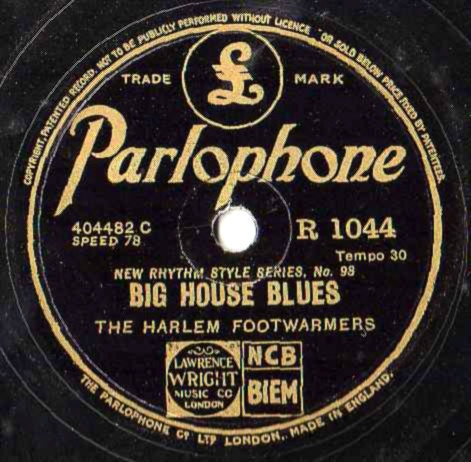
"Big House Blues" record label. Image courtesy ellingtonweb.ca
“Big House Blues” was recorded only once by Duke Ellington, in 1930 for Okeh under the name Duke Ellington and His Harlem Footwarmers. (“The “Big House” of the title refers to prison.) This tune has been in the Cullum Band playlist for decades and the Band’s performance here is true to the creative elements that set Ellington apart in this early period. The composition is highly imaginative; and Ellington’s sole recording features the idiosyncratic horn styling of trombonist “Tricky Sam” Nanton and clarinetist Barney Bigard with and a driving, propulsive 4/4 rhythm provided by New Orleans bassist Wellman Braud.
1931 was a period in which crooner Bing Crosby and trumpet star Louis Armstrong found themselves in close proximity living and working in Los Angeles. The two emerging artists struck up a personal and musical friendship during this time and freely borrowed musical approaches from each other. “I Surrender Dear,” composed that year by Harry Barris (a partner with Bing in Paul Whiteman’s Rhythm Boys) with lyricist Gordon Clifford, became Crosby’s first solo hit. Later that year, Armstrong became the first jazz artist to record it. He went on to record many of Crosby’s hit songs and Bing and Louis enjoyed a lifelong friendship. Here The Jim Cullum Jazz Band gives “I Surrender Dear” their unique jazz interpretation.
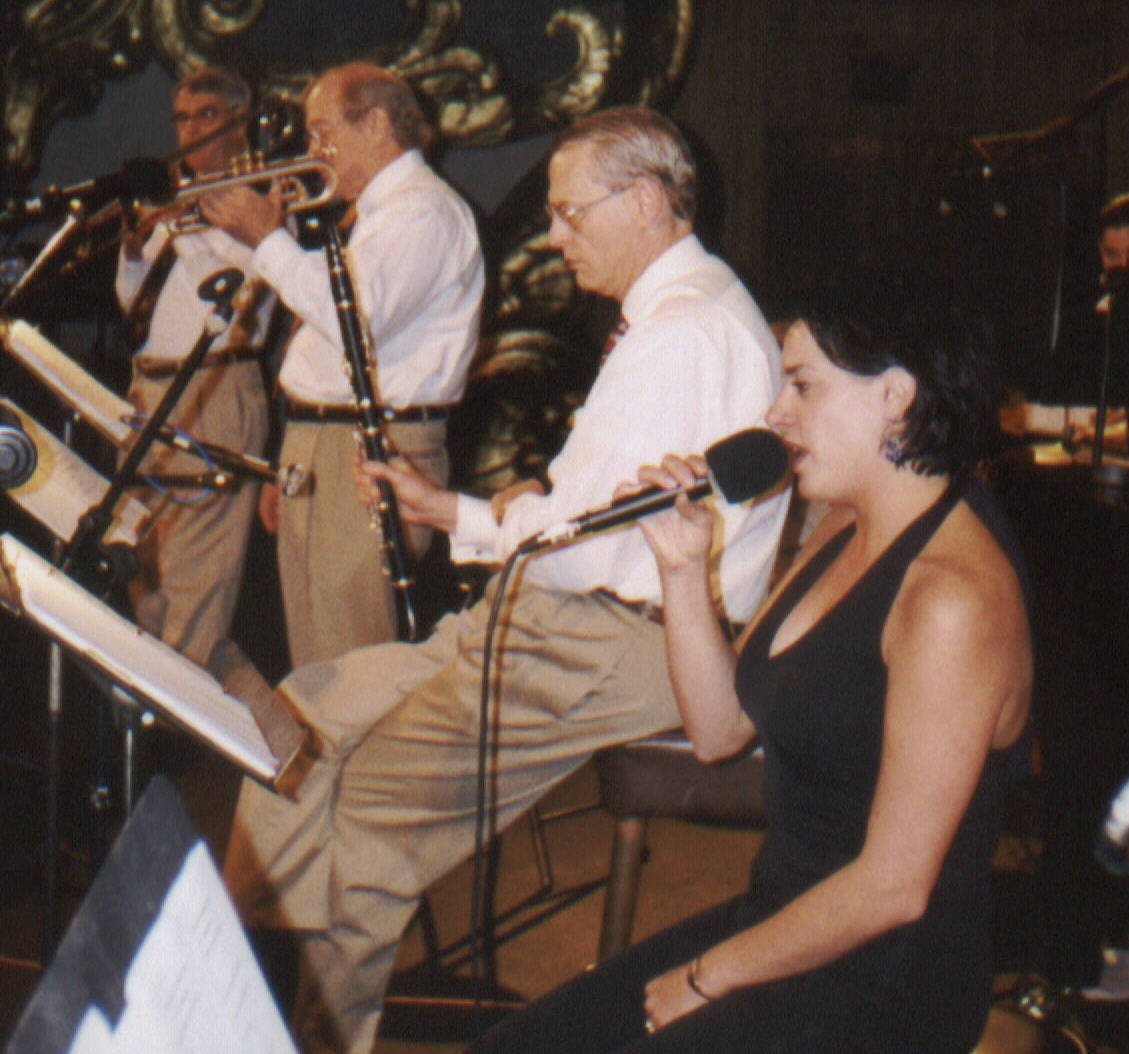
Nina Ferro with The Jim Cullum Jazz Band in Sacramento. Photo courtesy Riverwalk Jazz.
Nina Ferro rejoins the Cullum Band on a swinging rendition of “This Can’t Be Love” from “The Boys from Syracuse,” a 1938 Broadway musical scored by Rodgers and Hart, whose songwriting output is a cornerstone of the American Songbook. That same year Benny Goodman had a hit record with the number. Its bouncy melody lends itself well to up-tempo swinging and it has been recorded countless times by jazz and pop artists, among them Ella Fitzgerald and Nat Cole.
“Yellow Days” by Mexican composer Álvaro Carrillo is well known in the Latin music world as “La Mentira,” and ballroom dancers are familiar with it as a rhumba or bolero. Percy Faith had an “easy listening” hit with the English-language version featuring a female chorus in the 1960s; but Bobby Hackett’s 1969 jazz recording has provided Jim Cullum long standing inspiration. Nina Ferro joins the Band to offer her bittersweet vocal interpretation.
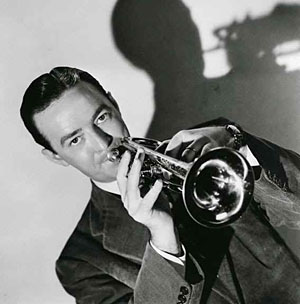
Bobby Hackett. Photo courtesy allaboutjazz
Our radio concert draws to a close with a set of tunes identified with Jazz Age cornetist Bix Beiderbecke, long a key source of inspiration for Jim Cullum. “Sorry,” “My Little Margie” and “’Tain’t So, Honey, ‘Tain’t So” were pop tunes recorded by Bix in the 1920s. Guitarist Howard Elkins takes the vocal on “’Tain’t So.” Our radio show concludes with an uptempo Fats Waller number from 1931 “I’m Crazy ‘Bout My Baby (And My Baby’s Crazy ‘Bout Me).”
Photo credit for Home Page. Nina Ferro. Photo courtesy of the artist.
Text based on Riverwalk Jazz script by Margaret Moos Pick © 1999

